Exploring Agronomic Management Strategies to Improve Millet, Sorghum, Peanuts and Rice in Senegal Using the DSSAT Models
Abstract
1. Introduction
1.1. General Questions for the Four Crops
- What are the gaps between current crop yield and attainable yields with crop management practices that maximize yields (planting dates, fertilizer, irrigation)?
- How does the yield interannual variability change with improved practices?
- What is the role of seasonal climate forecasts in adjusting crop management practices?
- What is the profitability of investing in improved varieties, fertilizers and irrigation?
1.2. Millet and Sorghum
- What is the impact of adjusting planting dates based on definitions of the onset of rainy season?
- What is the optimal strategy for N fertilizer management?
1.3. Peanuts
- What is the expected yield with varieties of different season lengths (long vs. short)?
- What is the feasibility of peanut production in different regions?
- What is the feasibility of irrigation for peanut production?
1.4. Rice
- What is the suitability of rainfed rice in selected regions of Senegal?
- What is the strategy for optimal N fertilizer management for rainfed rice?
- What are the crop irrigation needs in different regions, using different production strategies (to inform investments in irrigation infrastructure)?
- What is the feasibility of irrigated rice in single and double cropping systems in the Senegal River Valley?
2. Materials and Methods
2.1. Crop Simulation Models
2.2. Sites
2.3. Prices and Costs
3. Results and Discussion
3.1. Yield Gaps of Sorghum and Millet
3.1.1. Sorghum Yield Gap
3.1.2. Millet Yield Gap
3.2. Peanut Yield Gap
3.3. Rice Yield Gap
3.4. Optimal N Fertilizer Recommendations for Sorghum and Millet
3.4.1. Sorghum
3.4.2. Millet
| (a) ONSET | Sorghum Forecast * Post 51 DAS | N Recommendation ** (0 + 36 DAS + 51 DAS) |
| Early | N or A | 20 + 20 + 60 |
| Early | B | 20 + 20 + 30 |
| Late | N or A | 20 + 20 + 30 |
| Late | B | 20 + 20 + 0 |
| (b) ONSET | Millet Forecast * Post 41 DAS | N Recommendation ** (0 + 20 DAS + 41 DAS) |
| Early | N or A | 20 + 20 + 30 |
| Early | B | 20 + 20 + 0 |
| Late | N or A | 20 + 20 + 30 |
| Late | B | 20 + 20 + 0 |
3.5. Peanuts: Planting Dates, Varieties, and Feasibility of Irrigation
3.5.1. Planting Dates
3.5.2. Irrigation
3.6. Rice
3.6.1. N Fertilizer Strategy for Rainfed Rice
3.6.2. Irrigated Rice
4. Conclusions
Author Contributions
Funding
Data Availability Statement
Conflicts of Interest
Appendix A
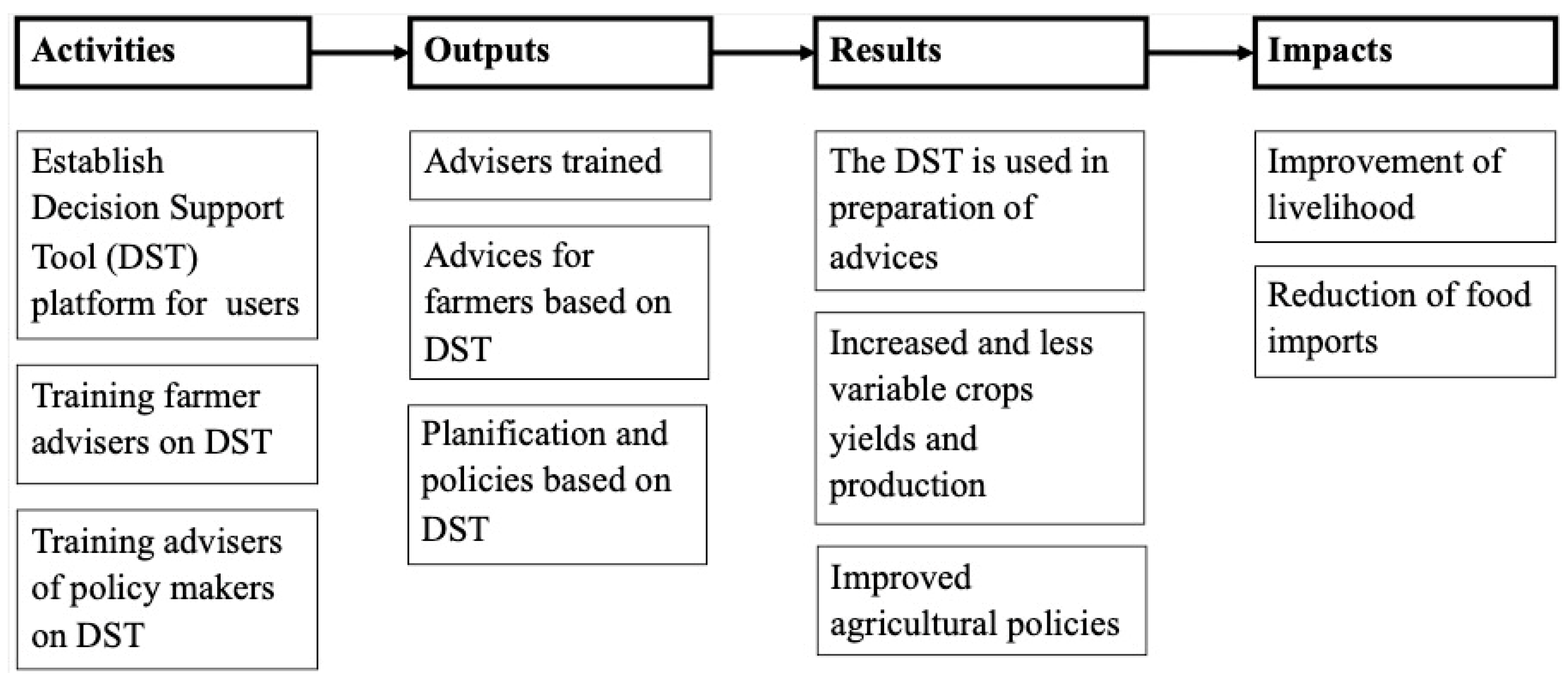
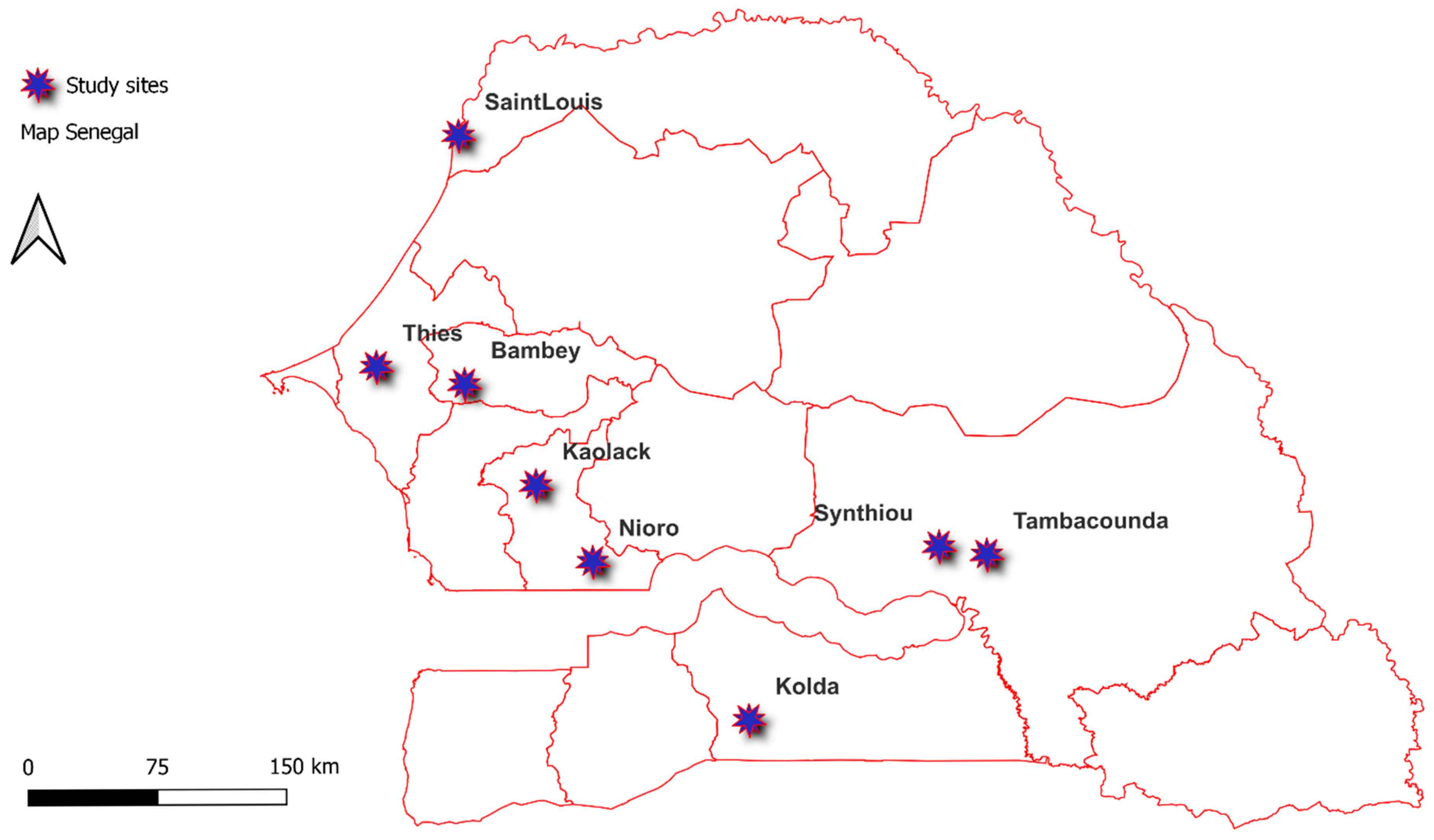
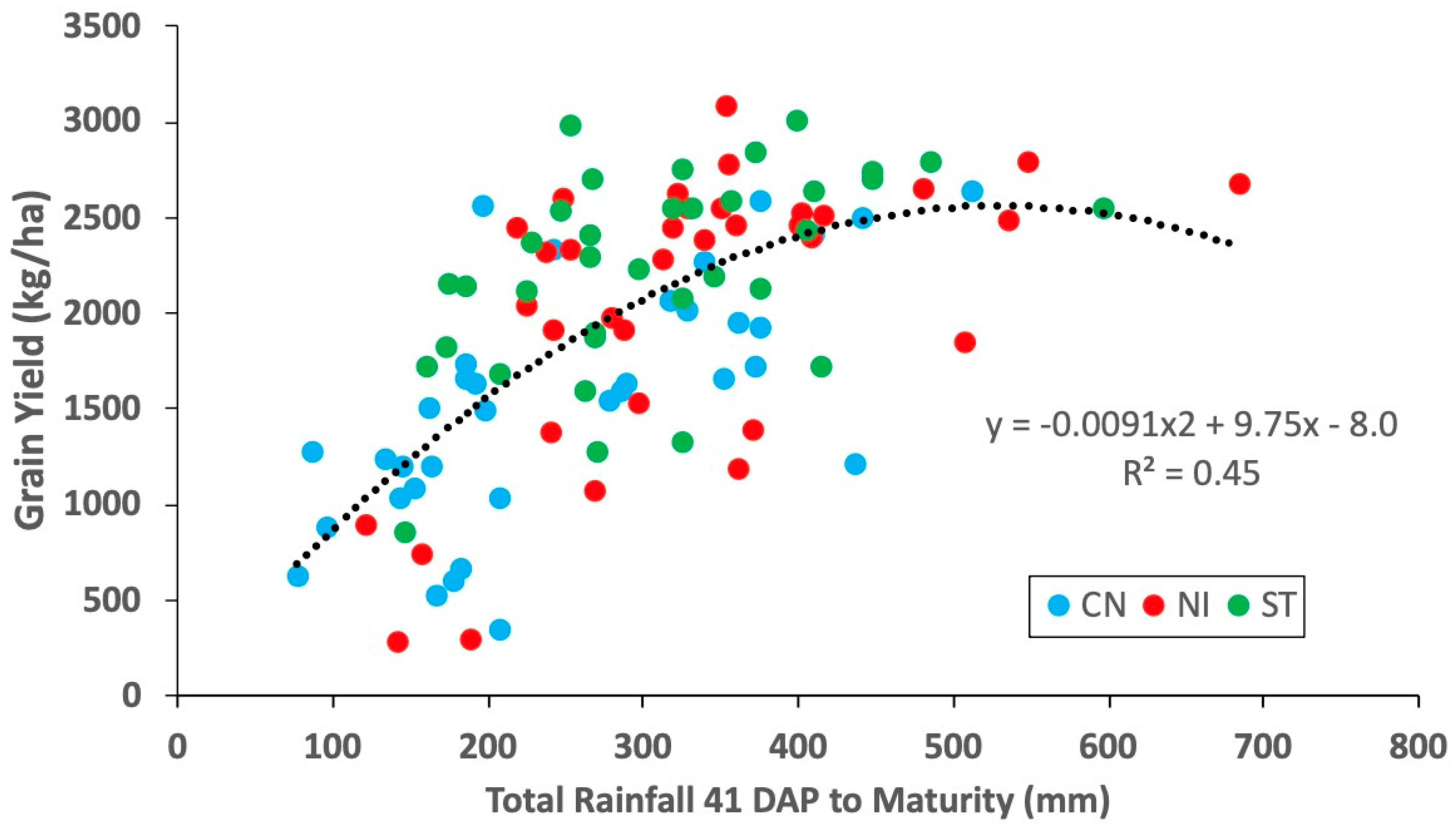
| Data | Description | Period | Application | Source |
|---|---|---|---|---|
| Sorghum field experiment data | Determine the effect of fertilizer application on sorghum grain yield and formulation of tailored fertilization strategies according to sorghum varieties | 2015–2016 | Calibration/Evaluation | [38,39] |
| Peanuts management and yield data | Effects of fertilization rate and water availability on peanut growth and yield | 2014–2015 | Calibration/Evaluation | [29] |
| Soil data | Analysis of soil physical and chemical properties at the experimental sites in 2014 | 2014–2015 | Calibration/Evaluation | [29] |
| Peanuts management and yield data | Evaluate the impact of climate change on peanut yield in Senegal | 2014–2015 | Calibration/Evaluation | [40] |
| Rice management and yield data | Measure the agronomic traits of four upland rainfed rice NERICA (NERICA 1 and NERICA 4 (95–100 days); NERICA 8 and NERICA 11 (75–85 days) in a sudano-sahelian zone | 2013–2014 | Calibration/Evaluation | [6] |
| SORGHUM | MILLET | |||
| Coefficient | FaddaW | Coefficient | CIVT | |
| P1 | 200.0 | P1 | 100.0 | |
| P2 | 280.0 | P2O | 12.0 | |
| P2O | 12.6 | P2R | 142.0 | |
| P2R | 655.0 | P5 | 390.0 | |
| PANTH | 617.5 | G1 | 1.0 | |
| P3 | 145.0 | G4 | 0.6 | |
| P4 | 81.5 | PHINT | 43.0 | |
| P5 | 400.0 | GT | 1.0 | |
| PHINT | 49.0 | G5 | 11.0 | |
| G1 | 3.0 | |||
| G2 | 6.0 | |||
| PEANUTS | Cultivar | RICE | ||
| Coefficient | FLEUR 11 | VAR 73-33 | Coefficient | NERICA 1&4 |
| CSDL | 11.84 | 11.84 | P1 | 380 |
| PPSEN | 0.0 | 0.0 | P2R | 100 |
| EM-FL | 16.0 | 20.0 | P5 | 300 |
| FL-SH | 7.0 | 7.6 | P2O | 13 |
| FL-SD | 12.0 | 13.0 | G1 | 75.0 |
| SD-PM | 36.0 | 40.0 | G2 | 0.03 |
| FL-LF | 66.0 | 66.0 | G3 | 1.0 |
| LFMAX | 1.7 | 1.55 | G4 | 83.0 |
| SLAVR | 250 | 250 | PHINT | 37.0 |
| SIZLF | 25.0 | 15.0 | ||
| XFRT | 0.95 | 0.9 | ||
| WTPSD | 0.36 | 0.36 | ||
| WTPSD | 0.36 | 0.36 | ||
| SFDUR | 29.0 | 25.0 | ||
| SDPDV | 1.65 | 1.65 | ||
| PODUR | 8.0 | 10.0 | ||
| THRSH | 95.0 | 95.0 | ||
| SDPRO | 0.7 | 0.7 | ||
| SDLIP | 0.51 | 0.51 | ||
| Sorghum | |||
|---|---|---|---|
| Base production cost | 156,500 CFA/ha | ||
| Nitrogen fertilizer | 1130 CFA/kg N | ||
| Sorghum price | 160 CFA/kg grain | ||
| Sorghum byproduct | 10 CFA/kg byproduct | ||
| Millet | |||
| Base production cost | 154,000 CFA/ha | ||
| Nitrogen fertilizer | 1130 CFA/kg N | ||
| Millet price | 160 CFA/kg grain | ||
| Millet byproduct | 5 CFA/kg byproduct | ||
| Peanuts | |||
| Base production cost | 395,700 CFA/ha | ||
| Irrigation | 630 CFA/mm | ||
| Peanut price | 280 CFA/kg grain | ||
| Peanut byproduct | 33 CFA/kg byproduct | ||
| Rice | |||
| Base production cost | 391,000 CFA/ha | ||
| Irrigation | 630 CFA/mm | ||
| Nitrogen fertilizer | 1130 CFA/kg N | ||
| Rice price | 180 CFA/kg Grain | ||
| Rice byproduct | 0 CFA/kg byproduct | ||
| Nerica 1 * | Nerica 8 * | ||||
|---|---|---|---|---|---|
| Observed | Simulated | Observed | Simulated | ||
| Anthesis | Median | 66.2 | 67.0 | 64.8 | 63.0 |
| Date (DAP) | Q25 | 63.7 | 66.0 | 61.0 | 63.0 |
| Q75 | 70.0 | 68.3 | 66.6 | 65.0 | |
| Maturity | Median | 92.0 | 91.0 | 86.0 | 88.0 |
| date (DAP) | Q25 | 86.0 | 90.0 | 85.0 | 87.0 |
| Q75 | 95.0 | 94.0 | 94.0 | 90.0 | |
| Yield (kg/ha) | Median | 1282 | 2180 | 1532 | 1896 |
| Q25 | 744 | 1629 | 840 | 1413 | |
| Q75 | 2131 | 2626 | 2656 | 2210 | |
References
- Sultan, B.; Gaetani, M. Agriculture in West Africa in the Twenty-First Century: Climate Change and Impacts Scenarios, and Potential for Adaptation. Front. Plant Sci. 2016, 7, 1262. [Google Scholar] [CrossRef]
- Direction de l’Analyse, de la Prévision et des Statistiques Agricoles: Rapport de l’Enquête Agricole Annuelle (EAA) 2020–2021; DAPSA: Dakar, Sénégal, 2021.
- Salack, S.; Klein, C.; Giannini, A.; Sarr, B.; Worou, O.N.; Belko, N.; Bliefernicht, J.; Kunstman, H. Global warming induced hybrid rainy seasons in the Sahel. Environ. Res. Lett. 2016, 11, 104008. [Google Scholar] [CrossRef]
- Sultan, B.; Defrance, D.; Iizumi, T. Evidence of crop production losses in West Africa due to historical global warming in two crop models. Sci. Rep. 2019, 9, 12834. [Google Scholar] [CrossRef]
- Brosseau, A.; Saito, K.; van Oort, P.A.; Diagne, M.; Valbuena, D.; Groot, J.C. Exploring opportunities for diversification of smallholders’ rice-based farming systems in the Senegal River Valley. Agric. Syst. 2021, 193, 103211. [Google Scholar] [CrossRef]
- Kouakou, K.P.M.; Muller, B.; Fofana, A.; Guisse, A. Agronomic performance of four varieties of NERICA upland rice sown on different dates in Sudano-Sahelian zone in Senegal. J. Appl. Biosci. 2016, 99, 9382–9394. [Google Scholar] [CrossRef][Green Version]
- Van Asten, P.J.A.; Wopereis, M.C.S.; Haefele, S.; Isselmou, M.O.; Kropff, M.J. Explaining yield gaps on farmer-identified degraded and non-degraded soils in a Sahelian irrigated rice scheme. NJAS-Wagening. J. Life Sci. 2003, 50, 277–296. [Google Scholar] [CrossRef]
- Fall, B. Recensement Général de la Population et de l’Habitat, de l’Agriculture et de l’Elevage (RGPHAE); ANSD: Dakar, Senegal, 2014. [Google Scholar]
- Araya, A.; Jha, P.K.; Zambreski, Z.; Faye, A.; Ciampitti, I.A.; Min, D.; Gowda, P.H.; Singh, U.; Prasad, P.V.V. Evaluating crop management options for sorghum, pearl millet and peanut to minimize risk under the projected midcentury climate scenario for different locations in Senegal. Clim. Risk Manag. 2022, 36, 100436. [Google Scholar] [CrossRef]
- Debieu, M.; Sine, B.; Passot, S.; Grondin, A.; Akata, E.; Gangashetty, P.; Vadez, V.; Gantet, P.; Foncéka, D.; Cournac, L. Response to early drought stress and identification of QTLs controlling biomass production under drought in pearl millet. PLoS ONE 2018, 13, e0201635. [Google Scholar] [CrossRef]
- Gowda, N.A.N.; Siliveru, K.; Prasad, P.V.V.; Bhatt, Y.; Netravati, B.P.; Gurikar, C. Modern processing of Indian millets: A perspective on changes in nutritional properties. Foods 2022, 11, 499. [Google Scholar] [CrossRef]
- Singh, P.; Singh, R.; Bhadauria, V.; Singh, H. The functionality and extraction of protein from sorghum, finger millet, and Kodo millet: A review. Int. J. Food Sci. Technol. 2023, 59, 512–521. [Google Scholar] [CrossRef]
- Dia, D.; Diop, A.M.; Fall, C.S.; Seck, T. Sur les Sentiers de la Collecte et de la Commercialisation de L’arachide au Sénégal: Tirer les Leçons du Passé Pour Rebâtir une Filière Performante; ISRA: Jeddah, Saudi Arabia, 2003. [Google Scholar]
- Sene, A.; Gueye, A.D.; Faye, I. Identification of Genetically Closely Related Peanut Varieties Using Deep Learning: The Case of Flower-Related Varieties 11. In Proceedings of the International Conference on Paradigms of Computing, Communication and Data Sciences, PCCDS 2022, Jaipur, India, 5–7 July 2023; pp. 273–283. [Google Scholar]
- Noba, K.; Ngom, A.; Guèye, M.; Bassène, C.; Kane, M.; Diop, I.; Ndoye, F.; Mbaye, M.S.; Kane, A.; Ba, A.T. L’arachide au Sénégal: État des lieux, contraintes et perspectives pour la relance de la filière. OCL 2014, 21, D205. [Google Scholar] [CrossRef]
- Baborska, R. Suivi des Politiques Agricoles et Alimentaires au Sénégal 2021: Rapport D’analyse Politique; Food & Agriculture Organization: Rome, Italy, 2021. [Google Scholar]
- Gama, A.P.; Adhikari, K.; Hoisington, D.A. Peanut consumption in Malawi: An opportunity for innovation. Foods 2018, 7, 112. [Google Scholar] [CrossRef]
- Allan, E.; Dunkel, F.; Lachapelle, P.; Kim, S.-H.; Kinnare, C.; Ndiaye, A.; Kuo, W.-Y. Developing culturally acceptable peanut nutrition bars with smallholder women farmers in Kaffrine, Senegal using participatory action research. Local Dev. Society 2023, 4, 289–311. [Google Scholar] [CrossRef]
- Kennedy, G.; Burlingame, B.; Nguyen, N. Nutrient impact assessment of rice in major rice consuming countries. Korea 2002, 165, 12–15. [Google Scholar]
- Danièle, C.; Verger, E.; Guetat-Bernard, H. Expanding and Intensifying Rice Production Consequences on Agrobiodiversity Management and Diet Quality. A Situated Transdisciplinary Gendered Analysis in Senegal Middle Valley River. 2020. Available online: https://hal.science/hal-02949499v1/document (accessed on 30 July 2025).
- Diallo, M.F.; Garba, A.A. Effect of Seed and Fertilizer Subsidies on the Technical Efficiency of Rice Farmers in Senegal. J. Agric. Sci. 2023, 16, 1–81. [Google Scholar] [CrossRef]
- Tanaka, A.; Diagne, M.; Saito, K. Causes of yield stagnation in irrigated lowland rice systems in the Senegal River Valley: Application of dichotomous decision tree analysis. Field Crop Res. 2015, 176, 99–1075. [Google Scholar] [CrossRef]
- THIAO, M.; Larbi, A. Analyse de la situation de la riziculture pluviale au sud du Sénégal. Rev. Marocaine Sci. Agron. Vétérinaires 2022, 10, 209–216. [Google Scholar]
- Kanfany, G.; El-Namaky, R.; Ndiaye, K.; Traore, K.; Ortiz, R. Assessment of rice inbred lines and hybrids under low fertilizer levels in Senegal. Sustainability 2014, 6, 1153–1162. [Google Scholar] [CrossRef]
- Gérardeaux, E.; Falconnier, G.; Gozé, E.; Defrance, D.; Kouakou, P.-M.; Loison, R.; Sultan, B.; Affholder, F.; Muller, B. Adapting rainfed rice to climate change: A case study in Senegal. Agron. Sustain. Dev. 2021, 41, 57. [Google Scholar] [CrossRef]
- Van Oosterom, E.J.; Weltzien, E.; Yadav, O.P.; Bidinger, F.R. Grain yield components of pearl millet under optimum conditions can be used to identify germplasm with adaptation to arid zones. Field Crop Res. 2006, 96, 407–421. [Google Scholar] [CrossRef]
- Soullier, G.; Moustier, P. The modernization of the rice value chain in Senegal: A move towards the Asian Quiet Revolution? Dev. Policy Rev. 2021, 39, O81–O101. [Google Scholar] [CrossRef]
- Faye, A.; Camara, I.; Diop, M.; OuryDiallo, A.; Sine, B.; Noblet, M.; Faye, B.; Defrance, D.; Sultan, B.; Ndour, N.Y.B. Millet and sorghum yield simulations under climate change scenarios in Senegal. Reg. Environ. Change 2022, 22, 86. [Google Scholar] [CrossRef]
- Faye, B.; Webber, H.; Gaiser, T.; Diop, M.; Owusu-Sekyere, J.D.; Naab, J.B. Effects of fertilization rate and water availability on peanut growth and yield in Senegal (West Africa). J. Sustain. Dev. 2016, 9, 111. [Google Scholar] [CrossRef]
- Wajid, A.; Hussain, K.; Ilyas, A.; Habib-ur-Rahman, M.; Shakil, Q.; Hoogenboom, G. Crop models: Important tools in decision support system to manage wheat production under vulnerable environments. Agriculture 2021, 11, 1166. [Google Scholar] [CrossRef]
- Han, E.; Baethgen, W.E.; Ines, A.V.M.; Mer, F.; Souza, J.S.; Berterretche, M.; Atunez, G.; Barreira, C. SIMAGRI: An agro-climate decision support tool. Comput. Electron. Agric. 2019, 161, 241–251. [Google Scholar] [CrossRef]
- Hoogenboom, G.; Jones, J.W.; Wilkens, P.W.; Porter, C.H.; Boote, K.J.; Hunt, L.A.; Singh, U.; Lizaso, J.I.; White, J.W.; Uryasev, O. Decision Support System for Agrotechnology Transfer (DSSAT) Version 4.6; DSSAT Foundation: Prosser, WA, USA, 2015. [Google Scholar]
- Jones, J.W.; Hoogenboom, G.; Porter, C.H.; Boote, K.J.; Batchelor, W.D.; Hunt, L.A.; Wilkens, P.W.; Singh, U.; Gijsman, A.J.; Ritchie, J.T. The DSSAT cropping system model. Eur. J. Agron. 2003, 18, 235–265. [Google Scholar] [CrossRef]
- Hoogenboom, G.; Porter, C.H.; Boote, K.J.; Shelia, V.; Wilkens, P.W.; Singh, U.; White, J.W.; Asseng, S.; Lizaso, J.I.; Moreno, L.P. The DSSAT crop modeling ecosystem. In Advances in Crop Modeling for a Sustainable Agriculture; Burleigh Dodds Science Publishing: Sawston, UK, 2019; pp. 173–216. ISBN 9780429266591. [Google Scholar]
- Asseng, S.; Foster, I.; Turner, N.C. The impact of temperature variability on wheat yields. Glob. Change Biol. 2011, 17, 997–1012. [Google Scholar] [CrossRef]
- Han, E.; Faye, A.; Diop, M.; Singh, B.; Ganyo, K.K.; Baethgen, W. Evaluating agronomic onset definitions in Senegal through crop simulation modeling. Atmosphere 2022, 13, 2122. [Google Scholar] [CrossRef]
- Baethgen, W.E.; Christianson, C.B.; Lamothe, A.G. Nitrogen fertilizer effects on growth, grain yield, and yield components of malting barley. Field Crops Res. 1995, 43, 87–99. [Google Scholar] [CrossRef]
- Ganyo, K.K.; Muller, B.; Ndiaye, M.; Gaglo, E.K.; Guissé, A.; Adam, M. Defining fertilization strategies for sorghum (Sorghum bicolor (L.) Moench) production under Sudano-Sahelian conditions: Options for late basal fertilizer application. Agronomy 2019, 9, 697. [Google Scholar] [CrossRef]
- Ganyo, K.K.; Muller, B.; Guissé, A.; Adam, M. Fertilization strategies based on climate information to enhance food security through improved dryland cereals production. In Handbook of Climate Change Resilience; Springer: Berlin/Heidelberg, Germany, 2018; pp. 1–18. [Google Scholar]
- Faye, B.; Webber, H.; Diop, M.; Mbaye, M.L.; Owusu-Sekyere, J.D.; Naab, J.B.; Gaiser, T. Potential impact of climate change on peanut yield in Senegal, West Africa. Field Crops Res. 2018, 219, 148–159. [Google Scholar] [CrossRef]
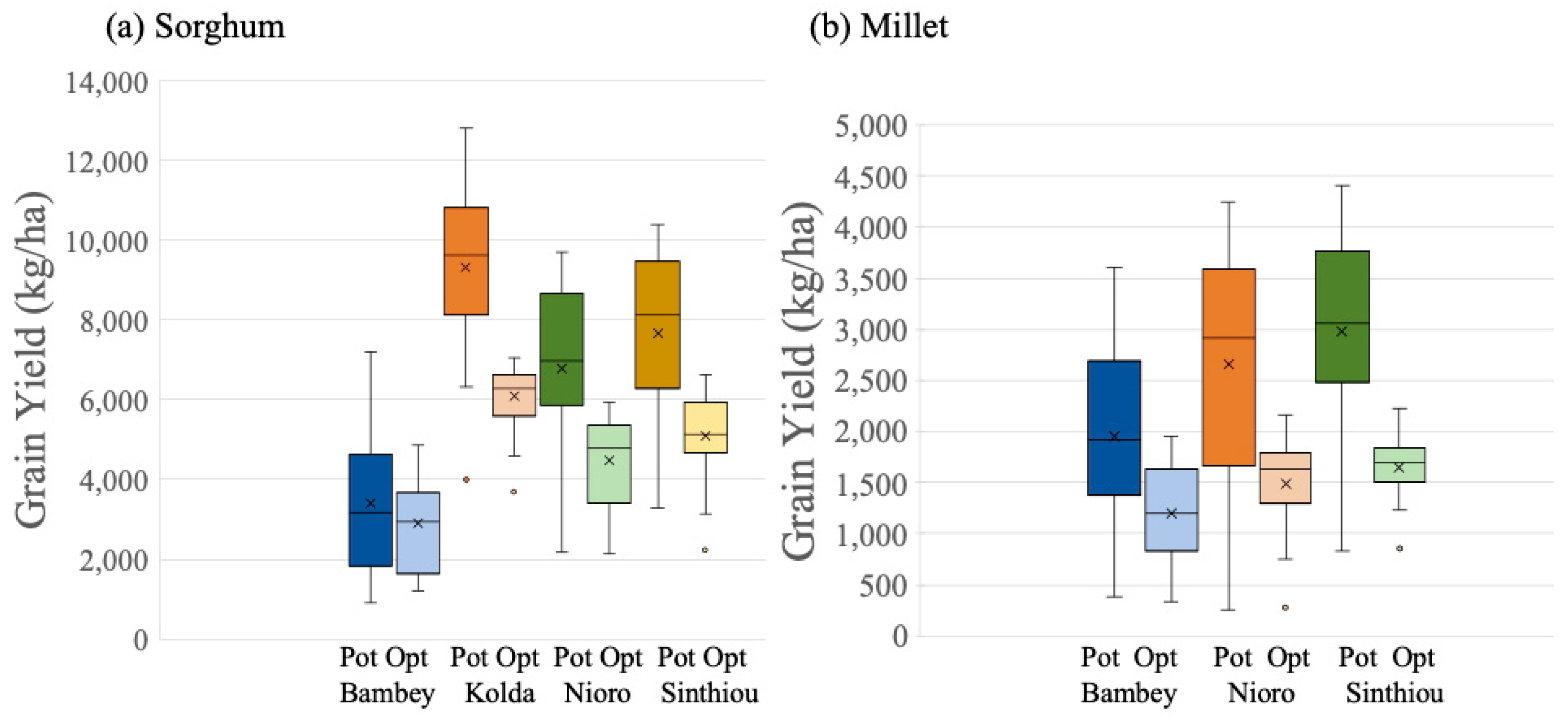
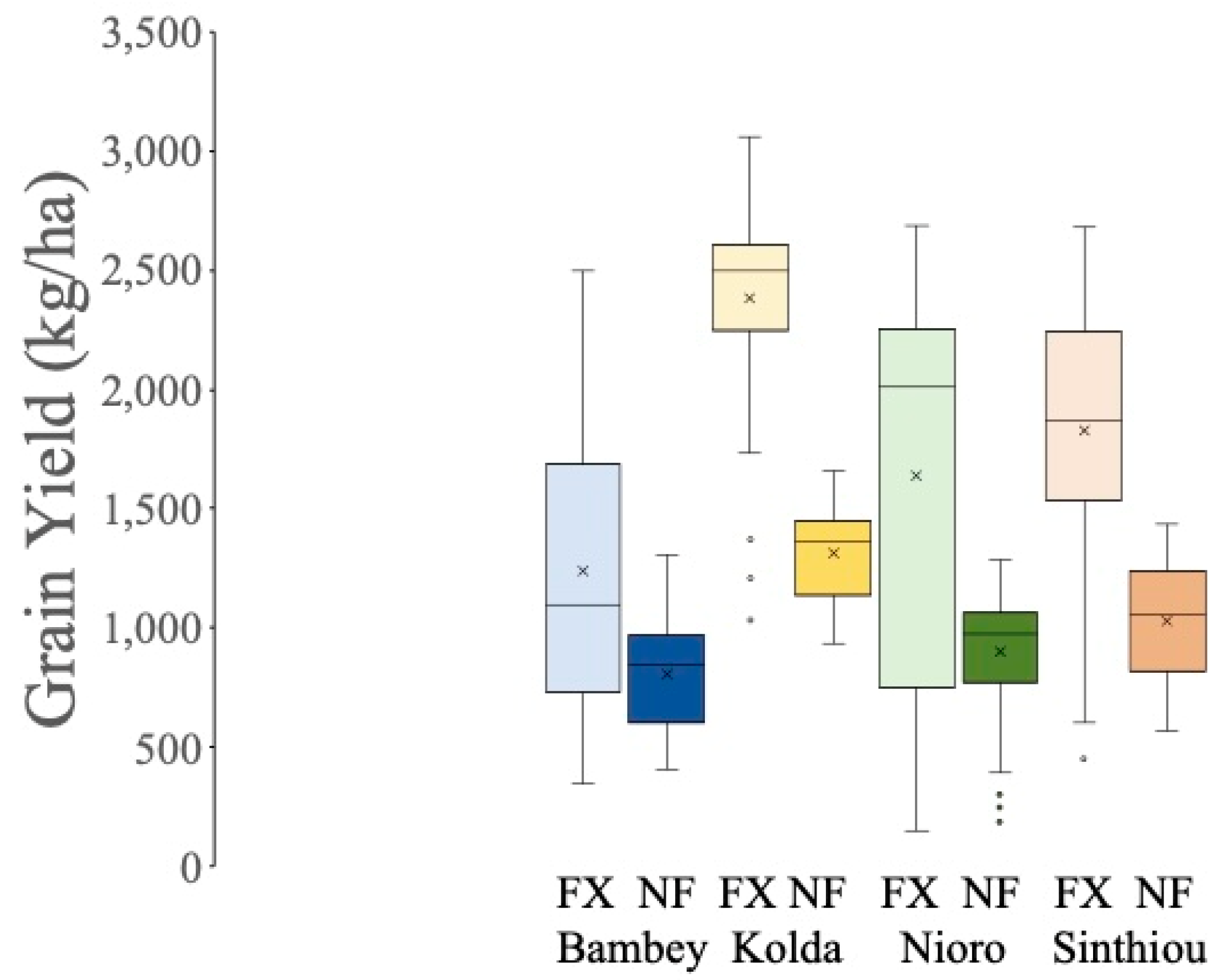
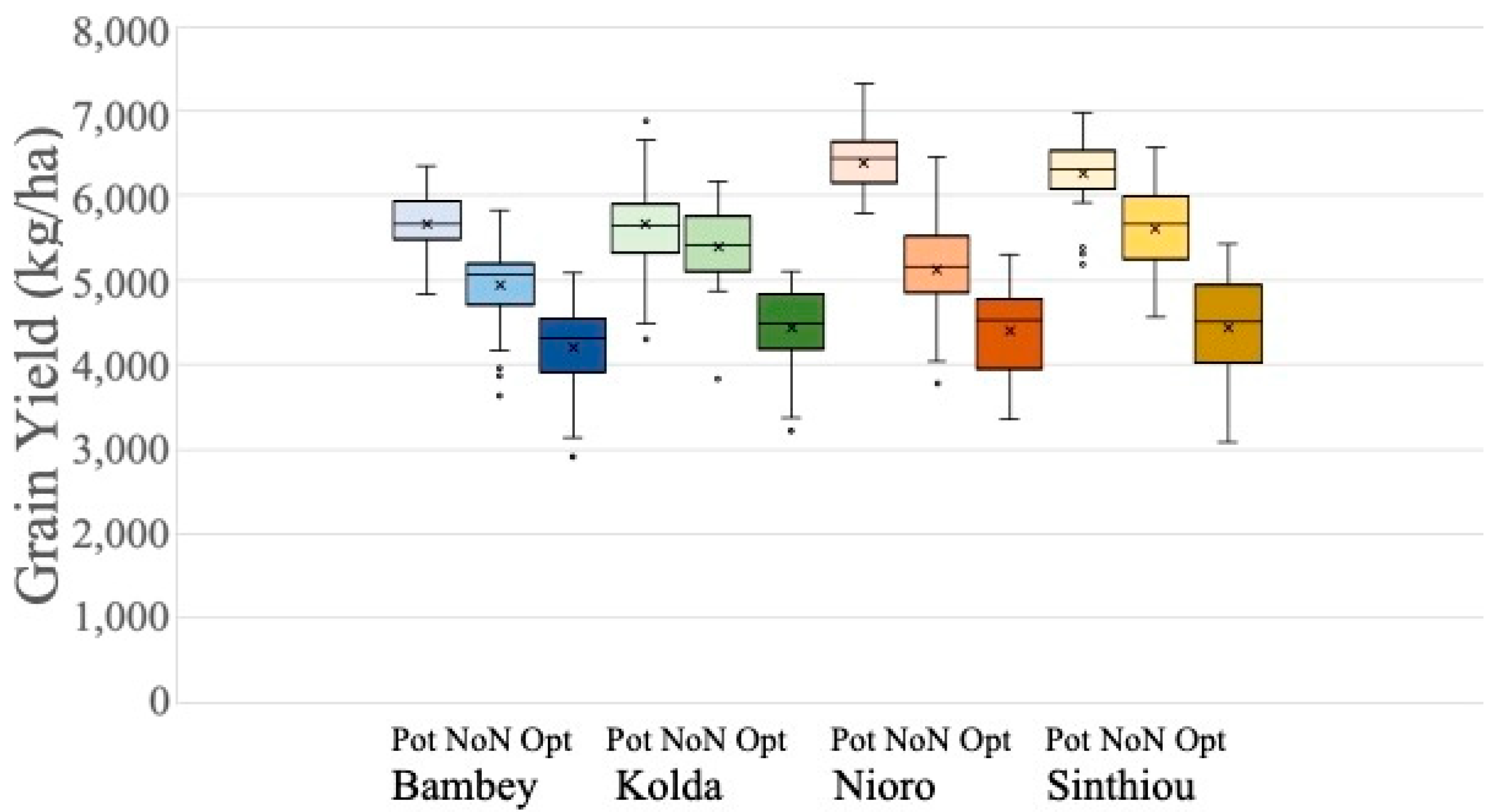
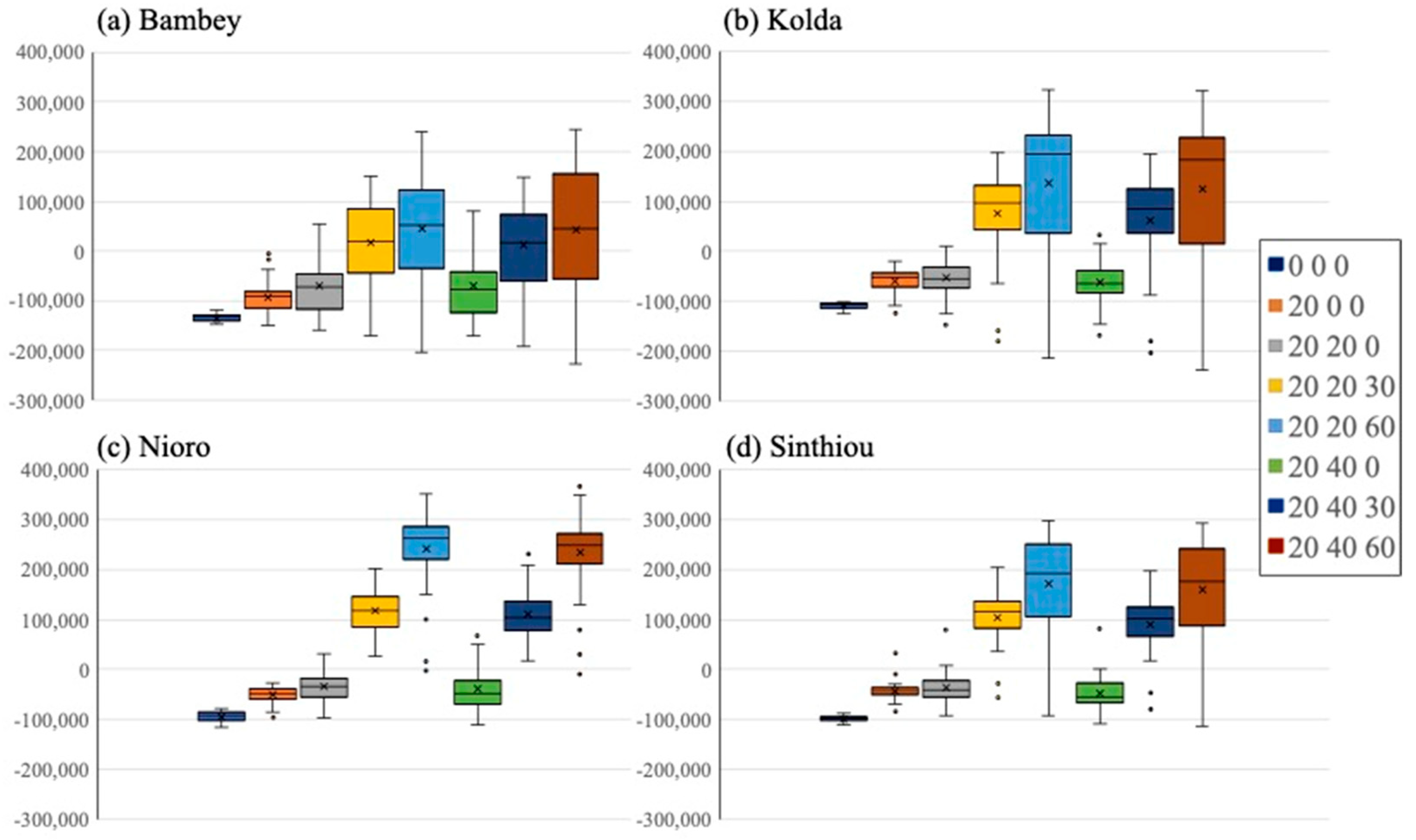
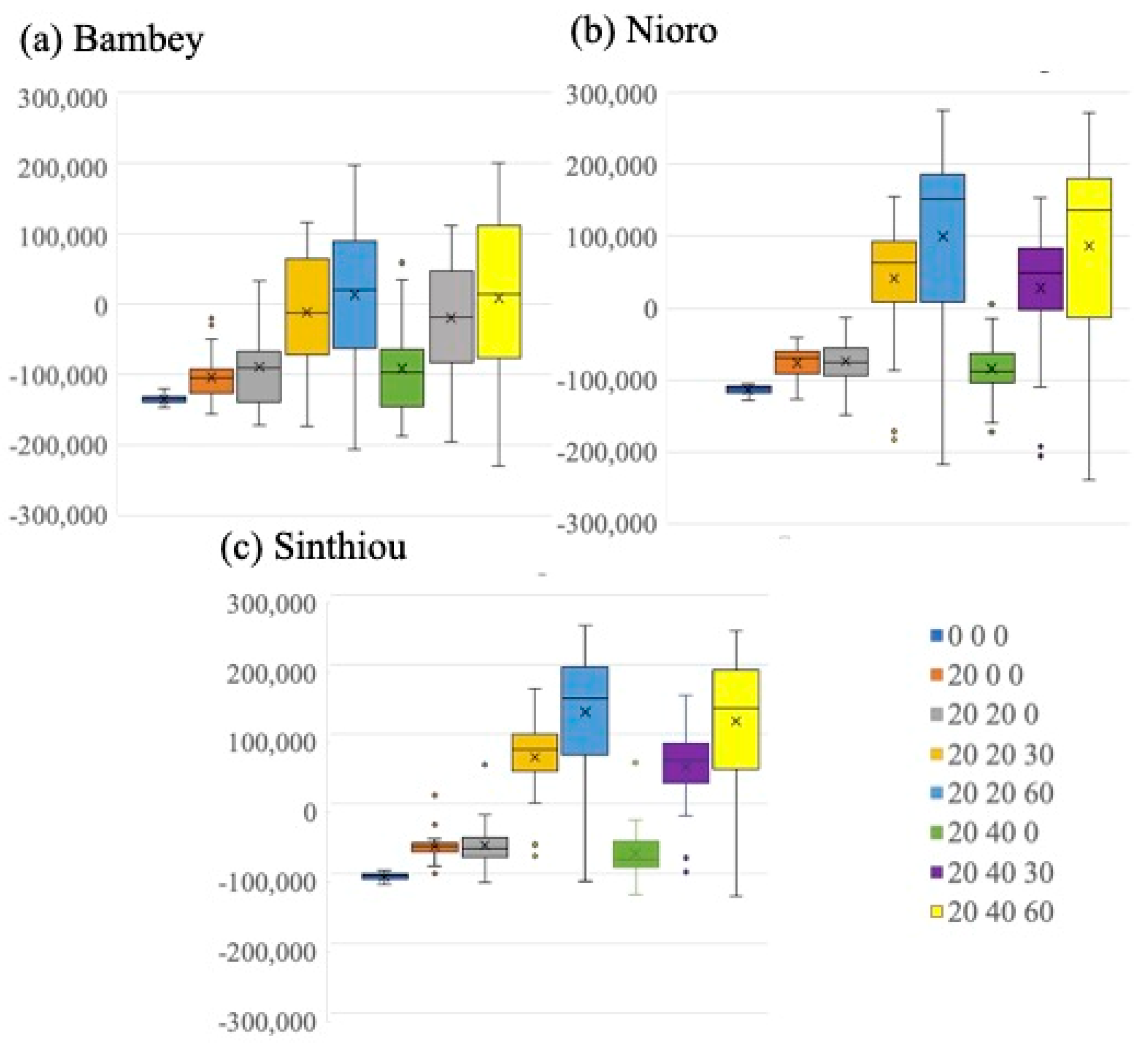
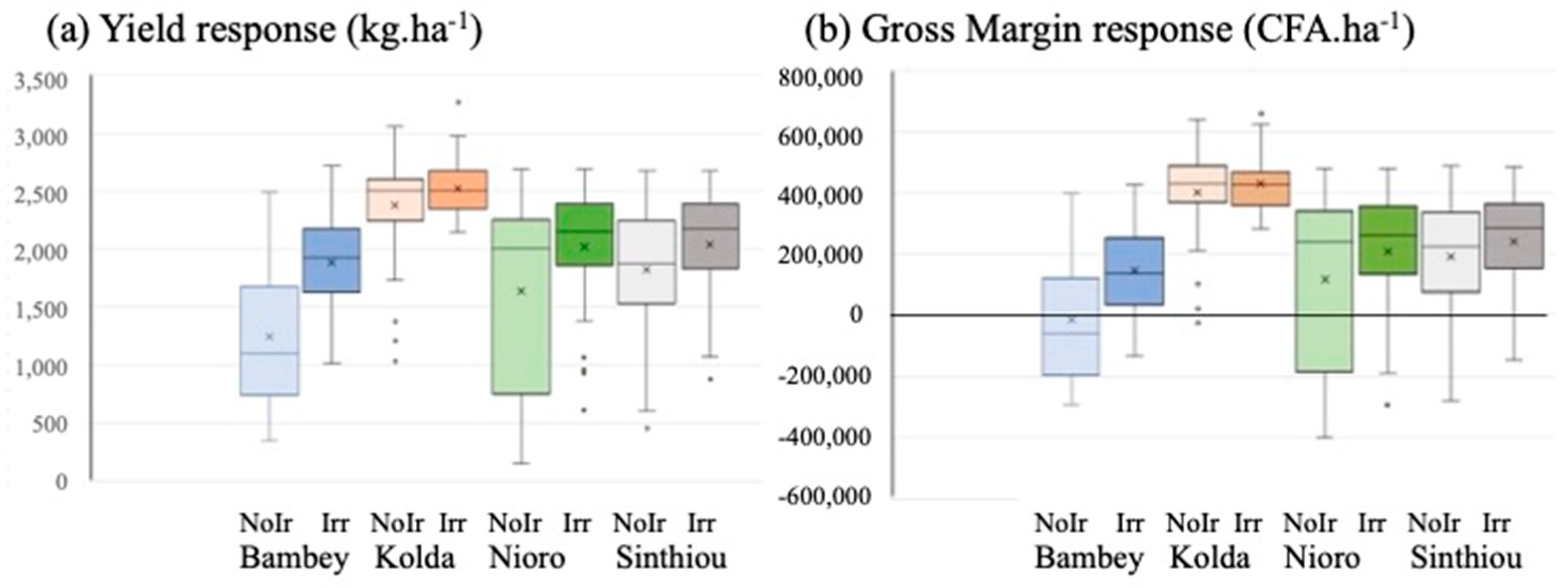

| N Fertilizer (kg N/ha) Applied at Sowing-36 DAS-51 DAS | ||||||||
|---|---|---|---|---|---|---|---|---|
| 0-0-0 | 20-0-0 | 20-20-0 | 20-20-30 | 20-20-60 | 20-40-0 | 20-40-30 | 20-40-60 | |
| Bambey | ||||||||
| Median | 124 | 674 | 928 | 1123 | 1241 | 1034 | 1207 | 1386 |
| Q25 | 107 | 634 | 839 | 1039 | 1128 | 943 | 1131 | 1217 |
| Q75 | 136 | 705 | 1028 | 1339 | 1458 | 1132 | 1489 | 1605 |
| Kolda | ||||||||
| Median | 2738 | 3415 | 4134 | 5032 | 6050 | 4875 | 5713 | 6816 |
| Q25 | 2379 | 2984 | 3607 | 4526 | 5465 | 4302 | 5285 | 6037 |
| Q75 | 2989 | 3707 | 4421 | 5309 | 6510 | 5119 | 6187 | 7471 |
| Nioro | ||||||||
| Median | 2463 | 2937 | 3712 | 4674 | 5371 | 4352 | 5185 | 5939 |
| Q25 | 2261 | 2830 | 3395 | 4223 | 5091 | 3984 | 4794 | 5468 |
| Q75 | 2723 | 3325 | 4012 | 4865 | 5711 | 4685 | 5498 | 6432 |
| Synthiou | ||||||||
| Median | 2677 | 3223 | 3829 | 4749 | 5572 | 4541 | 5279 | 6288 |
| Q25 | 2437 | 2899 | 3498 | 4319 | 5182 | 4069 | 4951 | 5563 |
| Q75 | 3062 | 3631 | 4338 | 5200 | 5974 | 4984 | 5779 | 6663 |
| N Fertilizer (kg N/ha) Applied at Sowing, 20 DAS and 41 DAS | ||||||||
|---|---|---|---|---|---|---|---|---|
| 0-0-0 | 20-0-0 | 20-20-0 | 20-20-30 | 20-20-60 | 20-40-0 | 20-40-30 | 20-40-60 | |
| Bambey | ||||||||
| Median | 91 | 358 | 546 | 1196 | 1581 | 599 | 1256 | 1694 |
| Q25 | 76 | 241 | 360 | 866 | 1132 | 372 | 931 | 1172 |
| Q75 | 115 | 423 | 657 | 1625 | 1980 | 776 | 1680 | 2229 |
| Nioro | ||||||||
| Median | 217 | 534 | 614 | 1631 | 2377 | 670 | 1655 | 2411 |
| Q25 | 185 | 449 | 517 | 1328 | 1687 | 578 | 1365 | 1735 |
| Q75 | 231 | 587 | 729 | 1777 | 2530 | 808 | 1854 | 2597 |
| Synthiou | ||||||||
| Median | 260 | 587 | 683 | 1691 | 2287 | 728 | 1727 | 2338 |
| Q25 | 234 | 539 | 637 | 1535 | 1881 | 679 | 1563 | 1942 |
| Q75 | 281 | 615 | 780 | 1821 | 2605 | 853 | 1881 | 2695 |
| Cultivar | 73-33 | Fleur 11 | ||||||
|---|---|---|---|---|---|---|---|---|
| Site | Bambey | Kolda | Nioro | Sinthiou | Bambey | Kolda | Nioro | Sinthiou |
| Yield (kg/ha) | ||||||||
| Median | 1099 | 2500 | 2012 | 1870 | 2342 | 4114 | 2612 | 2819 |
| Q25 | 744 | 2266 | 806 | 1573 | 1786 | 3637 | 1490 | 2244 |
| Q75 | 1626 | 2598 | 2254 | 2239 | 3090 | 4399 | 3272 | 3322 |
| Gross Margin (CFA/ha) | ||||||||
| Median | 23,590 | 512,628 | 324,879 | 308,530 | −49,876 | 302,828 | −25,829 | −25,829 |
| Q25 | −104,670 | 455,641 | −75,657 | 189,819 | −175,313 | 252,345 | −205,295 | −205,295 |
| Q75 | 203,010 | 564,101 | 411,182 | 418,506 | 35,616 | 366,724 | 129,320 | 129,320 |
| Bambey | Kolda | St Louis | Kaolak | Thies | Tambactou | |
|---|---|---|---|---|---|---|
| Optimal Planting | ||||||
| Date (DOY) | ||||||
| Median | 200 | 165 | 214 | 182 | 200 | 159 |
| Q25 | 182 | 159 | 196 | 170 | 189 | 155 |
| Q75 | 213 | 172 | 223 | 194 | 213 | 165 |
| Irrigation | ||||||
| need (mm) | ||||||
| Median | 165 | 21 | 205 | 75 | 144 | 57 |
| Q25 | 101 | 18 | 175 | 39 | 101 | 22 |
| Q75 | 212 | 40 | 224 | 114 | 165 | 81 |
| Yield (kg/ha) | ||||||
| Median | 7326 | 7000 | 7619 | 7516 | 7570 | 7479 |
| Q25 | 6682 | 6448 | 6842 | 7033 | 6898 | 7040 |
| Q75 | 7537 | 7421 | 7908 | 7870 | 7945 | 7799 |
| Gross Margin | ||||||
| (CFA/ha) | ||||||
| Median | 179,305 | 227,602 | 206,493 | 265,063 | 223,976 | 257,656 |
| Q25 | 116,928 | 184,085 | 99,341 | 228,539 | 171,500 | 211,849 |
| Q75 | 244,269 | 269,655 | 245,101 | 309,359 | 299,669 | 312,356 |
| Total Double Crop Gross Margin (CFA/ha) in St. Louis | |||||||||
|---|---|---|---|---|---|---|---|---|---|
| Rice = 150 CFA/kg and Irrigation Cost = 650 CFA/mm | |||||||||
| Jan–Jun | Jan–Jul | Jan–Aug | Feb–Jun | Feb–Jul | Feb–Aug | Mar–Jun | Mar–Jul | Mar–Aug | |
| Median | 56,260 | 141,340 | 44,254 | 57,240 | 117,555 | 19,345 | 253,480 | 309,052 | 210,906 |
| Q25 | 34,218 | 105,081 | −1746 | 8518 | 63,335 | −37,548 | 125,691 | 194,535 | 103,742 |
| Q75 | 125,195 | 198,576 | 88,894 | 99,855 | 175,053 | 90,693 | 352,979 | 386,198 | 299,541 |
| Rice = 150 CFA/kg and Irrigation Cost = 1100 CFA/mm | |||||||||
| Median | −223,955 | −123,335 | −224,448 | −224,810 | −166,200 | −266,710 | 140,161 | 227,396 | 118,574 |
| Q25 | −264,778 | −144,205 | −261,814 | −293,090 | −199,475 | −311,905 | −1906 | 93,992 | 9561 |
| Q75 | −155,943 | −55,810 | −171,844 | −191,925 | −75,885 | −177,100 | 252,186 | 303,469 | 198,418 |
| Rice = 200 CFA/kg and Irrigation Cost = 650 CFA/mm | |||||||||
| Median | 529,195 | 623,990 | 504,500 | 518,225 | 592,345 | 470,165 | 491,644 | 538,595 | 423,831 |
| Q25 | 501,292 | 574,263 | 449,533 | 456,480 | 514,440 | 390,165 | 363,167 | 446,576 | 307,694 |
| Q75 | 613,694 | 701,624 | 563,585 | 577,633 | 671,165 | 546,780 | 590,479 | 630,042 | 518,652 |
| Rice = 200 CFA/kg and Irrigation Cost = 1100 CFA/mm | |||||||||
| Median | 242,202 | 369,182 | 240,524 | 232,520 | 314,855 | 175,330 | 365,481 | 450,821 | 304,328 |
| Q25 | 200,843 | 319,198 | 179,989 | 162,388 | 251,060 | 111,328 | 232,107 | 326,906 | 219,217 |
| Q75 | 336,370 | 447,738 | 294,531 | 276,908 | 404,675 | 285,248 | 487,980 | 542,816 | 410,319 |
| 1st Crop 2nd Crop | Jan 30 * Jul 30 | Jan 50 Jul 30 | Jan 30 Jul 50 | Jan 50 Jul 50 |
|---|---|---|---|---|
| Median | 208,875 | 368,340 | 410,435 | 542,975 |
| P5 | −110,907 | 186,703 | 15,953 | 392,922 |
| P25 | 76,183 | 300,123 | 332,988 | 494,355 |
| P75 | 318,305 | 487,533 | 471,738 | 607,480 |
| P95 | 422,989 | 609,047 | 582,882 | 707,378 |
Disclaimer/Publisher’s Note: The statements, opinions and data contained in all publications are solely those of the individual author(s) and contributor(s) and not of MDPI and/or the editor(s). MDPI and/or the editor(s) disclaim responsibility for any injury to people or property resulting from any ideas, methods, instructions or products referred to in the content. |
© 2025 by the authors. Licensee MDPI, Basel, Switzerland. This article is an open access article distributed under the terms and conditions of the Creative Commons Attribution (CC BY) license (https://creativecommons.org/licenses/by/4.0/).
Share and Cite
Baethgen, W.E.; Faye, A.; Diop, M. Exploring Agronomic Management Strategies to Improve Millet, Sorghum, Peanuts and Rice in Senegal Using the DSSAT Models. Agronomy 2025, 15, 1882. https://doi.org/10.3390/agronomy15081882
Baethgen WE, Faye A, Diop M. Exploring Agronomic Management Strategies to Improve Millet, Sorghum, Peanuts and Rice in Senegal Using the DSSAT Models. Agronomy. 2025; 15(8):1882. https://doi.org/10.3390/agronomy15081882
Chicago/Turabian StyleBaethgen, Walter E., Adama Faye, and Mbaye Diop. 2025. "Exploring Agronomic Management Strategies to Improve Millet, Sorghum, Peanuts and Rice in Senegal Using the DSSAT Models" Agronomy 15, no. 8: 1882. https://doi.org/10.3390/agronomy15081882
APA StyleBaethgen, W. E., Faye, A., & Diop, M. (2025). Exploring Agronomic Management Strategies to Improve Millet, Sorghum, Peanuts and Rice in Senegal Using the DSSAT Models. Agronomy, 15(8), 1882. https://doi.org/10.3390/agronomy15081882







